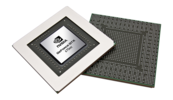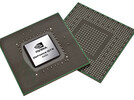NVIDIA GeForce GTX 680MX vs NVIDIA GeForce GTX 675MX vs NVIDIA GeForce GTX 660M
NVIDIA GeForce GTX 680MX ► remove from comparison Die NVIDIA GeForce GTX 680MX ist eine mobile, DirectX 11 fähige Grafikkarte der High-End-Klasse, welche speziell für den Einsatz in Apples iMac vorgesehen ist. Sie basiert wie die GTX 680M auf dem GK104-Chip der Kepler-Architektur (28-nm-Prozess), bietet allerdings statt 1344 alle 1536 1D-Shader. Die Kerntaktrate ist mit 720 MHz jedoch identisch. Der Speichertakt (GDDR5) wurde von 900 auf 1.250 MHz (5.000 MHz effektiv) angehoben, wodurch die Speicherbandbreite von 115.2 auf 160 GB/s steigt.
Architektur
Mit Kepler löst Nvidia die bisherige Fermi-Architektur ab, die unter anderem bei verschiedenen Chips und Modellen der GeForce-500M-Serie zum Einsatz kam. Der GK104 verfügt als Kepler-Chip über 8 Shader-Blöcke mit je 192 CUDA Cores, die vom Hersteller mit dem Kürzel SMX bezeichnet werden. Bei der 680MX sind alle 8 aktiviert. Zwei SMX bilden zusammen mit zwei Polymorph Engines und einer gemeinsamen Raster Engine einen sogenannten GPC (Graphics Processing Cluster). Da die Shader keine eigene Takt-Domain mehr besitzen (Hot Clock), entspricht die Rechenleistung in etwa der Hälfte der Einheiten der Fermi-Architektur mit doppelter Taktrate. Diese Änderung ist einer der Gründe dafür, dass sich laut Nvidia die Energieeffizienz gegenüber dem Vorgänger verdoppelt hat. Auch die Tesselations-Leistung soll - speziell bei hohen Faktoren - noch einmal deutlich verbessert worden sein.
Als weitere Neuerungen werden zudem erstmals PCIe 3.0 sowie ein noch nicht näher bezeichneter, optionaler Turbo-Modus unterstützt. Dieser kann - ausreichende Kühlungsreserven vorausgesetzt - die Kerntaktrate um bis zu 15 Prozent anheben. Da der Turbo vom BIOS gesteuert wird, steht er, falls vom Notebook-Hersteller implementiert, unabhängig vom Betriebssystem zur Verfügung.
Leistung
Die Grafikleistung sollte durch die zusätzlichen Shadereinheiten sowie den deutlich gesteigerten Speichertakt um etwa 15 bis 25 Prozent oberhalb der GTX 680M liegen. Die GTX 680MX ist damit die schnellste mobile Grafikkarte (wenn auch nur in Apples iMac eingesetzt) und sollte das Niveau einer Desktop GTX 580 erreichen. Nahezu alle Spiele des Jahres 2012 sind damit in maximalen Einstellungen und hoher Auflösung flüssig spielbar.
Battlefield 3 zum Beispiel war in der nativen Auflösung mit 30 fps (Ultra Settings ) in unserer Benchmarksequenz noch flüssig spielbar. Für Multiplayergefechte empfiehlt sich jedoch auf Antialiasing zu verzichten, oder auf 1920x1080 (45 fps) zurückzuschalten.
Features
Das aktualisierte Featureset umfasst nun die Unterstützung von bis zu 4 aktiven Displays (mit Optimus u.U. weniger), die mit einer maximalen Auflösung von 3840 x 2160 Pixeln zum Beispiel über DisplayPort 1.2 oder HDMI 1.4a angesteuert werden können. HD-Audio-Formate wie Dolby True HD und DTS-HD lassen sich als Bitstream an einen geeigneten Receiver senden. Wie in der Vergangenheit kann jedoch auch weiterhin 3D Vision nicht mit Optimus-Unterstützung kombiniert werden.
Der HD-Videoprozessor der fünften Generation (VP5) wurde vom GF119-Chip übernommen. Dieser kann die Formate MPEG-1, MPEG-2, MPEG-4, H.264 und VC1/WMV9 bis zu einer Auflösung von 4k decodieren und somit den Prozessor entlasten. Auch zwei parallele Streams, beispielsweise für Picture-in-Picture bei einer Blu-Ray, sind möglich. Eine weitere Neuerung ist die Integration eines dedizierten Videoencoders ähnlich Intels Quick Sync, der über die NVENC-API angesprochen werden kann.
Gegenüber der GTX 680M (100 Watt) dürfte die Leistungsaufnahme weiter angestiegen sein, was die Kühlung der Grafikkarte erschwert. Bislang ist uns kein Hersteller bekannt, der die GTX 680MX auch in Notebooks verbauen möchte, sodass sich der Einsatz auf Apples iMac beschränkt. Gerüchte sprechen derzeit von 122 Watt Stromverbrauch. Im Leerlauf kann die GPU mithilfe der Optimus-Technologie zugunsten einer integrierten Grafikeinheit auch vollständig deaktiviert werden (nur ohne 3D Vision).
NVIDIA GeForce GTX 675MX ► remove from comparison Die NVIDIA GeForce GTX 675MX ist eine DirectX 11.1 fähige Notebook-Grafikkarte der Oberklasse. Sie ist die Nachfolgerkarte der noch Fermi basierten GTX 675M und basiert auf dem GK104-Chip der Kepler-Architektur (28-nm-Prozess). Dadurch ist sie der GTX 680M ähnlich, bietet jedoch weniger Shader.
Architektur
Mit Kepler löst Nvidia die bisherige Fermi-Architektur ab, die unter anderem bei verschiedenen Chips und Modellen der GeForce-500M-Serie zum Einsatz kam. Der GK104 verfügt als Kepler-Chip über 8 Shader-Blöcke mit je 192 CUDA Cores, die vom Hersteller mit dem Kürzel SMX bezeichnet werden. Bei der 675MX sind davon 5 aktiviert. Zwei SMX bilden zusammen mit zwei Polymorph Engines und einer gemeinsamen Raster Engine einen sogenannten GPC (Graphics Processing Cluster). Da die Shader keine eigene Takt-Domain mehr besitzen (Hot Clock), entspricht die Rechenleistung in etwa der Hälfte der Einheiten der Fermi-Architektur mit doppelter Taktrate. Diese Änderung ist einer der Gründe dafür, dass sich laut Nvidia die Energieeffizienz gegenüber dem Vorgänger verdoppelt hat. Auch die Tesselations-Leistung soll - speziell bei hohen Faktoren - noch einmal deutlich verbessert worden sein.
Als weitere Neuerungen werden zudem erstmals PCIe 3.0 sowie ein noch nicht näher bezeichneter, optionaler Turbo-Modus unterstützt. Dieser kann - ausreichende Kühlungsreserven vorausgesetzt - die Kerntaktrate um bis zu 15 Prozent anheben. Da der Turbo vom BIOS gesteuert wird, steht er, falls vom Notebook-Hersteller implementiert, unabhängig vom Betriebssystem zur Verfügung.
Leistung
Die Grafikleistung der GeForce GTX 675MX liegt deutlich über der alten Fermi basierten GTX 675M und in der Region der GTX 560M SLI . Das High-End Modell GTX 680M ist hingegen etwa 30 bis 50 % schneller. Dennoch laufen auch anspruchsvolle Spiele in maximalen Details und hohen Auflösungen flüssig. Lediglich Metro 2033 ruckelte bei unserem Test mit maximalen Settings.
Features
Das aktualisierte Featureset umfasst nun die Unterstützung von bis zu 4 aktiven Displays (mit Optimus u.U. weniger), die mit einer maximalen Auflösung von 3840 x 2160 Pixeln zum Beispiel über DisplayPort 1.2 oder HDMI 1.4a angesteuert werden können. HD-Audio-Formate wie Dolby True HD und DTS-HD lassen sich als Bitstream an einen geeigneten Receiver senden. Wie in der Vergangenheit kann jedoch auch weiterhin 3D Vision nicht mit Optimus-Unterstützung kombiniert werden.
Der HD-Videoprozessor der fünften Generation (VP5) wurde vom GF119-Chip übernommen. Dieser kann die Formate MPEG-1, MPEG-2, MPEG-4, H.264 und VC1/WMV9 bis zu einer Auflösung von 4k decodieren und somit den Prozessor entlasten. Auch zwei parallele Streams, beispielsweise für Picture-in-Picture bei einer Blu-Ray, sind möglich. Eine weitere Neuerung ist die Integration eines dedizierten Videoencoders ähnlich Intels Quick Sync, der über die NVENC-API angesprochen werden kann.
Die Leistungsaufnahme der GTX 675MX sollte durch die niedrigeren Taktraten und den teildeaktivierten Chip etwas unterhalb der GTX 680M liegen. Dennoch eignet sich die GTX 675MX eher für große und schwere Notebooks (15-17"+). Bei geringer Last helfen zusätzliche Taktstufen, um Energie zu sparen. Im Leerlauf kann die GPU mithilfe der Optimus-Technologie zugunsten einer integrierten Grafikeinheit auch vollständig deaktiviert werden (nur ohne 3D Vision).
NVIDIA GeForce GTX 660M ► remove from comparison Die NVIDIA GeForce GTX 660M ist eine DirectX 11 Notebook-Grafikkarte der oberen Mittelklasse, welche im 1. Quartal 2012 vorgestellt wurde. Sie basiert auf dem GK107 Chip der Kepler-Serie und wird in 28nm bei TSMC hergestellt. Die GTX 660M repräsentiert die derzeit schnellste Ausbaustufe des GK107 und wird ausschließlich mit GDDR5 an einem 128 Bit breiten Speicherinterface angeboten.
Architektur
Mit Kepler löst Nvidia die bisherige Fermi-Architektur ab, die unter anderem bei verschiedenen Chips und Modellen der GeForce-500M-Serie zum Einsatz kam. Der GK107 verfügt als derzeit kleinster Kepler-Chip über 2 Shader-Blöcke, die vom Hersteller mit dem Kürzel SMX bezeichnet werden. Zusammen mit zwei Polymorph Engines und einer gemeinsamen Raster Engine bilden diese einen sogenannten GPC (Graphics Processing Cluster). Da die Shader keine eigene Takt-Domain mehr besitzen (Hot Clock), entspricht die Rechenleistung der 384 ALUs in etwa 192 Einheiten der Fermi-Architektur mit doppelter Taktrate. Diese Änderung ist einer der Gründe dafür, dass sich laut Nvidia die Energieeffizienz gegenüber dem Vorgänger verdoppelt hat. Auch die Tesselations-Leistung soll, speziell bei hohen Faktoren, noch einmal deutlich verbessert worden sein. Als zusätzliche Neuerungen werden zudem erstmals PCIe 3.0 sowie ein noch nicht näher bezeichneter, optionaler Turbo-Modus unterstützt. Dieser kann, ausreichende Kühlungsreserven vorausgesetzt, die Kerntaktrate um bis zu 15 Prozent anheben. Da der Turbo vom BIOS gesteuert wird, steht er, falls vom Notebook-Hersteller implementiert, unabhängig vom Betriebssystem zur Verfügung.
Leistung
Die Performance der GeForce GTX 660M liegt durch den schnellen GDDR5-Speicher etwas oberhalb der DDR3-Version der GT 650M und erreicht in etwa das ältere High-End-Modell Radeon HD 6950M . Auch die Fermi-basierte GeForce GTX 570M kann sich kaum absetzen. Die meisten anspruchsvollen Spiele wie Anno 2070 oder Battlefield 3 sind somit in hohen Detailstufen flüssig darstellbar, weniger fordernde Titel teils auch mit zusätzlichem Antialiasing (Stand Frühjahr 2012).
Features
Das aktualisierte Featureset umfasst nun die Unterstützung von bis zu 4 aktiven Displays (mit Optimus u.U. weniger), die mit einer maximalen Auflösung von 3840 x 2160 Pixeln zum Beispiel über DisplayPort 1.2 oder HDMI 1.4a angebunden werden können. HD-Audio-Formate wie Dolby True HD und DTS-HD lassen sich als Bitstream an einen geeigneten Receiver senden. Wie in der Vergangenheit kann jedoch auch weiterhin 3D Vision nicht mit Optimus-Unterstützung kombiniert werden.
Der PureVideo HD Videoprozessor der fünften Generation (VP5) wurde vom GF119-Chip übernommen. Dieser kann die Formate MPEG-1, MPEG-2, MPEG-4, H.264 und VC1/WMV9 bis zu einer Auflösung von 4k decodieren und somit den Prozessor entlasten. Auch zwei parallele Streams, beispielsweise für Picture-in-Picture bei einer Blu-Ray, sind möglich. Eine weitere Neuerung ist die Integration eines dedizierten Videoencoders ähnlich Intels Quick Sync, der über die NVENC-API angesprochen werden kann.
Die Leistungsaufnahme der GeForce GTX 660M sollte für Notebooks im Bereich 15-17 Zoll geeignet sein. Bei geringer Last helfen zusätzliche Taktstufen dabei, Energie einzusparen, im Leerlauf kann die GPU mit Hilfe der Optimus-Technologie zugunsten eines IGP auch vollständig deaktiviert werden.
NVIDIA GeForce GTX 680MX NVIDIA GeForce GTX 675MX NVIDIA GeForce GTX 660M GeForce GTX 600M Serie Architektur Kepler Kepler Kepler Pipelines 1536 - unified 960 - unified 384 - unified Kerntakt 720 MHz 600 MHz 835 MHz Speichertakt 5000 MHz 3600 MHz 4000 MHz Speicherbandbreite 256 Bit 256 Bit 128 Bit Speichertyp GDDR5 GDDR5 GDDR5 Max. Speichergröße 2048 MB 2048 MB Shared Memory nein nein nein API DirectX 11, Shader 5.0, OpenGL 4.3 DirectX 11, Shader 5.0, OpenGL 4.1 DirectX 11, Shader 5.0 Stromverbrauch 122 Watt 100 Watt Transistors 3.5 Billion 3.5 Billion Herstellungsprozess 28 nm 28 nm 28 nm Features Optimus, SLI, PhysX,
Verde Drivers,
CUDA, 3D Vision, 3DTV
Play Optimus,
PhysX, Verde
Drivers,
CUDA, 3D
Vision, 3DTV
Play Optimus, SLI, PhysX,
Verde Drivers,
CUDA, 3D Vision, 3DTV
Play Notebookgröße groß (17" z.B.) groß (17" z.B.) groß (17" z.B.) Erscheinungsdatum 23.10.2012 01.10.2012 22.03.2012 Herstellerseite www.geforce.com www.geforce.com Codename N13E-GSR N13E-GE
Benchmarks
Spiele-Benchmarks Die folgenden Benchmarks basieren auf unseren Spieletests mit Testnotebooks. Die Performance dieser Grafikkarte bei den gelisteten Spielen ist abhängig von der verwendeten CPU, Speicherausstattung, Treiber und auch Betriebssystem. Dadurch müssen die untenstehenden Werte nicht repräsentativ sein. Detaillierte Informationen über das verwendete System sehen Sie nach einem Klick auf den fps-Wert.
100%
GeForce GTX 680MX:
72 [X] Apple iMac 27 Late 2012 BTO 680MX Core-i5 GeForce GTX 680MX
min:
62 fps, max:
84 fps
fps
100%
GeForce GTX 680MX:
43.6 [X] Apple iMac 27 Late 2012 BTO 680MX Core-i5 GeForce GTX 680MX
min:
36 fps, max:
55 fps
fps
100%
GeForce GTX 680MX:
26.4 [X] Apple iMac 27 Late 2012 BTO 680MX Core-i5 GeForce GTX 680MX
min:
20 fps, max:
35 fps
fps
100%
GeForce GTX 680MX:
14.2 [X] Apple iMac 27 Late 2012 BTO 680MX Core-i5 GeForce GTX 680MX
min:
11 fps, max:
18 fps
fps
GeForce GTX 675MX:
60 [X] Schenker XMG P502 Intel Core i7-3610QM 2.3GHz
GeForce GTX 675MX
fps
GeForce GTX 660M:
60 [X] Schenker XMG P502 Intel Core i7-3610QM 2.3GHz
GeForce GTX 660M
fps
GeForce GTX 675MX:
59 [X] Schenker XMG P502 Intel Core i7-3610QM 2.3GHz
GeForce GTX 675MX
fps
GeForce GTX 660M:
49.3 [X] Schenker XMG P502 Intel Core i7-3610QM 2.3GHz
GeForce GTX 660M
fps
GeForce GTX 675MX:
52.1 [X] Schenker XMG P502 Intel Core i7-3610QM 2.3GHz
GeForce GTX 675MX
fps
GeForce GTX 660M:
39.4 [X] Schenker XMG P502 Intel Core i7-3610QM 2.3GHz
GeForce GTX 660M
fps
GeForce GTX 675MX:
39.7 [X] Schenker XMG P502 Intel Core i7-3610QM 2.3GHz
GeForce GTX 675MX
fps
GeForce GTX 660M:
20.8 [X] Schenker XMG P502 Intel Core i7-3610QM 2.3GHz
GeForce GTX 660M
fps
GeForce GTX 675MX:
55 [X] Schenker XMG P502 Intel Core i7-3610QM 2.3GHz
GeForce GTX 675MX
fps
GeForce GTX 660M:
46 [X] Schenker XMG P502 Intel Core i7-3610QM 2.3GHz
GeForce GTX 660M
fps
GeForce GTX 675MX:
46.6 [X] Schenker XMG P502 Intel Core i7-3610QM 2.3GHz
GeForce GTX 675MX
fps
GeForce GTX 660M:
30.7 [X] Schenker XMG P502 Intel Core i7-3610QM 2.3GHz
GeForce GTX 660M
fps
GeForce GTX 675MX:
41 [X] Schenker XMG P502 Intel Core i7-3610QM 2.3GHz
GeForce GTX 675MX
fps
GeForce GTX 660M:
26.4 [X] Schenker XMG P502 Intel Core i7-3610QM 2.3GHz
GeForce GTX 660M
fps
GeForce GTX 675MX:
23.4 [X] Schenker XMG P502 Intel Core i7-3610QM 2.3GHz
GeForce GTX 675MX
fps
GeForce GTX 660M:
13 [X] Schenker XMG P502 Intel Core i7-3610QM 2.3GHz
GeForce GTX 660M
fps
GeForce GTX 675MX:
61.4 [X] Schenker XMG P502 Intel Core i7-3610QM 2.3GHz
GeForce GTX 675MX
fps
GeForce GTX 660M:
57.2 [X] Schenker XMG P502 Intel Core i7-3610QM 2.3GHz
GeForce GTX 660M
fps
GeForce GTX 675MX:
59.4 [X] Schenker XMG P502 Intel Core i7-3610QM 2.3GHz
GeForce GTX 675MX
fps
GeForce GTX 660M:
45.3 [X] Schenker XMG P502 Intel Core i7-3610QM 2.3GHz
GeForce GTX 660M
fps
GeForce GTX 675MX:
39.8 [X] Schenker XMG P502 Intel Core i7-3610QM 2.3GHz
GeForce GTX 675MX
fps
GeForce GTX 660M:
26.4 [X] Schenker XMG P502 Intel Core i7-3610QM 2.3GHz
GeForce GTX 660M
fps
GeForce GTX 675MX:
21 [X] Schenker XMG P502 Intel Core i7-3610QM 2.3GHz
GeForce GTX 675MX
fps
GeForce GTX 660M:
13.6 [X] Schenker XMG P502 Intel Core i7-3610QM 2.3GHz
GeForce GTX 660M
fps
GeForce GTX 675MX:
83.1 [X] Schenker XMG P502 Intel Core i7-3610QM 2.3GHz
GeForce GTX 675MX
fps
GeForce GTX 660M:
82.2 [X] Schenker XMG P502 Intel Core i7-3610QM 2.3GHz
GeForce GTX 660M
fps
GeForce GTX 675MX:
39 [X] Schenker XMG P502 Intel Core i7-3610QM 2.3GHz
GeForce GTX 675MX
fps
GeForce GTX 660M:
38.4 [X] Schenker XMG P502 Intel Core i7-3610QM 2.3GHz
GeForce GTX 660M
fps
GeForce GTX 675MX:
21.3 [X] Schenker XMG P502 Intel Core i7-3610QM 2.3GHz
GeForce GTX 675MX
fps
GeForce GTX 660M:
18.7 [X] Schenker XMG P502 Intel Core i7-3610QM 2.3GHz
GeForce GTX 660M
fps
GeForce GTX 675MX:
13.7 [X] Schenker XMG P502 Intel Core i7-3610QM 2.3GHz
GeForce GTX 675MX
fps
GeForce GTX 660M:
10 [X] Schenker XMG P502 Intel Core i7-3610QM 2.3GHz
GeForce GTX 660M
fps
GeForce GTX 675MX:
76.5 [X] Schenker XMG P502 Intel Core i7-3610QM 2.3GHz
GeForce GTX 675MX
fps
GeForce GTX 660M:
75.1 [X] Schenker XMG P502 Intel Core i7-3610QM 2.3GHz
GeForce GTX 660M
fps
GeForce GTX 675MX:
74.3 [X] Schenker XMG P502 Intel Core i7-3610QM 2.3GHz
GeForce GTX 675MX
fps
GeForce GTX 660M:
59.4 [X] Schenker XMG P502 Intel Core i7-3610QM 2.3GHz
GeForce GTX 660M
fps
GeForce GTX 675MX:
44.8 [X] Schenker XMG P502 Intel Core i7-3610QM 2.3GHz
GeForce GTX 675MX
fps
GeForce GTX 660M:
32.6 [X] Schenker XMG P502 Intel Core i7-3610QM 2.3GHz
GeForce GTX 660M
fps
GeForce GTX 675MX:
25.8 [X] Schenker XMG P502 Intel Core i7-3610QM 2.3GHz
GeForce GTX 675MX
fps
GeForce GTX 660M:
16.3 [X] Schenker XMG P502 Intel Core i7-3610QM 2.3GHz
GeForce GTX 660M
fps
GeForce GTX 675MX:
109.1 [X] Schenker XMG P502 Intel Core i7-3610QM 2.3GHz
GeForce GTX 675MX
fps
GeForce GTX 660M:
77.7 [X] Schenker XMG P502 Intel Core i7-3610QM 2.3GHz
GeForce GTX 660M
fps
GeForce GTX 675MX:
80.1 [X] Schenker XMG P502 Intel Core i7-3610QM 2.3GHz
GeForce GTX 675MX
fps
GeForce GTX 660M:
53.4 [X] Schenker XMG P502 Intel Core i7-3610QM 2.3GHz
GeForce GTX 660M
fps
GeForce GTX 675MX:
53.2 [X] Schenker XMG P502 Intel Core i7-3610QM 2.3GHz
GeForce GTX 675MX
fps
GeForce GTX 660M:
34.8 [X] Schenker XMG P502 Intel Core i7-3610QM 2.3GHz
GeForce GTX 660M
fps
GeForce GTX 675MX:
23.9 [X] Schenker XMG P502 Intel Core i7-3610QM 2.3GHz
GeForce GTX 675MX
fps
GeForce GTX 660M:
14.9 [X] Schenker XMG P502 Intel Core i7-3610QM 2.3GHz
GeForce GTX 660M
fps
GeForce GTX 675MX:
230 [X] Schenker XMG P502 Intel Core i7-3610QM 2.3GHz
GeForce GTX 675MX
fps
GeForce GTX 660M:
187 [X] Schenker XMG P502 Intel Core i7-3610QM 2.3GHz
GeForce GTX 660M
fps
GeForce GTX 675MX:
162 [X] Schenker XMG P502 Intel Core i7-3610QM 2.3GHz
GeForce GTX 675MX
fps
GeForce GTX 660M:
118 [X] Schenker XMG P502 Intel Core i7-3610QM 2.3GHz
GeForce GTX 660M
fps
GeForce GTX 675MX:
87 [X] Schenker XMG P502 Intel Core i7-3610QM 2.3GHz
GeForce GTX 675MX
fps
GeForce GTX 660M:
58 [X] Schenker XMG P502 Intel Core i7-3610QM 2.3GHz
GeForce GTX 660M
fps
GeForce GTX 675MX:
43 [X] Schenker XMG P502 Intel Core i7-3610QM 2.3GHz
GeForce GTX 675MX
fps
GeForce GTX 660M:
27 [X] Schenker XMG P502 Intel Core i7-3610QM 2.3GHz
GeForce GTX 660M
fps
GeForce GTX 675MX:
155 [X] Schenker XMG P502 Intel Core i7-3610QM 2.3GHz
GeForce GTX 675MX
fps
GeForce GTX 660M:
154 [X] Schenker XMG P502 Intel Core i7-3610QM 2.3GHz
GeForce GTX 660M
fps
GeForce GTX 675MX:
120 [X] Schenker XMG P502 Intel Core i7-3610QM 2.3GHz
GeForce GTX 675MX
fps
GeForce GTX 660M:
112 [X] Schenker XMG P502 Intel Core i7-3610QM 2.3GHz
GeForce GTX 660M
fps
GeForce GTX 675MX:
114 [X] Schenker XMG P502 Intel Core i7-3610QM 2.3GHz
GeForce GTX 675MX
fps
GeForce GTX 660M:
102 [X] Schenker XMG P502 Intel Core i7-3610QM 2.3GHz
GeForce GTX 660M
fps
GeForce GTX 675MX:
73 [X] Schenker XMG P502 Intel Core i7-3610QM 2.3GHz
GeForce GTX 675MX
fps
GeForce GTX 660M:
41 [X] Schenker XMG P502 Intel Core i7-3610QM 2.3GHz
GeForce GTX 660M
fps
GeForce GTX 675MX:
432.3 [X] Schenker XMG P502 Intel Core i7-3610QM 2.3GHz
GeForce GTX 675MX
fps
GeForce GTX 660M:
485.5 [X] Schenker XMG P502 Intel Core i7-3610QM 2.3GHz
GeForce GTX 660M
fps
GeForce GTX 675MX:
319.1 [X] Schenker XMG P502 Intel Core i7-3610QM 2.3GHz
GeForce GTX 675MX
fps
GeForce GTX 660M:
287.9 [X] Schenker XMG P502 Intel Core i7-3610QM 2.3GHz
GeForce GTX 660M
fps
GeForce GTX 675MX:
312.9 [X] Schenker XMG P502 Intel Core i7-3610QM 2.3GHz
GeForce GTX 675MX
fps
GeForce GTX 660M:
286.4 [X] Schenker XMG P502 Intel Core i7-3610QM 2.3GHz
GeForce GTX 660M
fps
GeForce GTX 675MX:
268.6 [X] Schenker XMG P502 Intel Core i7-3610QM 2.3GHz
GeForce GTX 675MX
fps
GeForce GTX 660M:
170.2 [X] Schenker XMG P502 Intel Core i7-3610QM 2.3GHz
GeForce GTX 660M
fps
GeForce GTX 675MX:
186.8 [X] Schenker XMG P502 Intel Core i7-3610QM 2.3GHz
GeForce GTX 675MX
fps
GeForce GTX 660M:
118.8 [X] Schenker XMG P502 Intel Core i7-3610QM 2.3GHz
GeForce GTX 660M
fps
GeForce GTX 675MX:
138.2 [X] Schenker XMG P502 Intel Core i7-3610QM 2.3GHz
GeForce GTX 675MX
fps
GeForce GTX 660M:
86.3 [X] Schenker XMG P502 Intel Core i7-3610QM 2.3GHz
GeForce GTX 660M
fps
GeForce GTX 675MX:
106.7 [X] Schenker XMG P502 Intel Core i7-3610QM 2.3GHz
GeForce GTX 675MX
fps
GeForce GTX 660M:
67.7 [X] Schenker XMG P502 Intel Core i7-3610QM 2.3GHz
GeForce GTX 660M
fps
GeForce GTX 675MX:
18.5 [X] Schenker XMG P502 Intel Core i7-3610QM 2.3GHz
GeForce GTX 675MX
fps
GeForce GTX 660M:
16.1 [X] Schenker XMG P502 Intel Core i7-3610QM 2.3GHz
GeForce GTX 660M
fps
GeForce GTX 675MX:
79.1 [X] Schenker XMG P502 Intel Core i7-3610QM 2.3GHz
GeForce GTX 675MX
fps
GeForce GTX 660M:
79.6 [X] Schenker XMG P502 Intel Core i7-3610QM 2.3GHz
GeForce GTX 660M
fps
GeForce GTX 675MX:
68.2 [X] Schenker XMG P502 Intel Core i7-3610QM 2.3GHz
GeForce GTX 675MX
fps
GeForce GTX 660M:
67.4 [X] Schenker XMG P502 Intel Core i7-3610QM 2.3GHz
GeForce GTX 660M
fps
GeForce GTX 675MX:
49 [X] Schenker XMG P502 Intel Core i7-3610QM 2.3GHz
GeForce GTX 675MX
fps
GeForce GTX 660M:
33.4 [X] Schenker XMG P502 Intel Core i7-3610QM 2.3GHz
GeForce GTX 660M
fps
GeForce GTX 675MX:
32.8 [X] Schenker XMG P502 Intel Core i7-3610QM 2.3GHz
GeForce GTX 675MX
fps
GeForce GTX 660M:
20.8 [X] Schenker XMG P502 Intel Core i7-3610QM 2.3GHz
GeForce GTX 660M
fps
GeForce GTX 675MX:
121.7 [X] Schenker XMG P502 Intel Core i7-3610QM 2.3GHz
GeForce GTX 675MX
fps
GeForce GTX 660M:
105.4 [X] Schenker XMG P502 Intel Core i7-3610QM 2.3GHz
GeForce GTX 660M
fps
GeForce GTX 675MX:
91.1 [X] Schenker XMG P502 Intel Core i7-3610QM 2.3GHz
GeForce GTX 675MX
fps
GeForce GTX 660M:
57.1 [X] Schenker XMG P502 Intel Core i7-3610QM 2.3GHz
GeForce GTX 660M
fps
GeForce GTX 675MX:
41.5 [X] Schenker XMG P502 Intel Core i7-3610QM 2.3GHz
GeForce GTX 675MX
fps
GeForce GTX 660M:
24.8 [X] Schenker XMG P502 Intel Core i7-3610QM 2.3GHz
GeForce GTX 660M
fps
GeForce GTX 675MX:
25.7 [X] Schenker XMG P502 Intel Core i7-3610QM 2.3GHz
GeForce GTX 675MX
fps
GeForce GTX 660M:
14.8 [X] Schenker XMG P502 Intel Core i7-3610QM 2.3GHz
GeForce GTX 660M
fps
GeForce GTX 675MX:
94.3 [X] Schenker XMG P502 Intel Core i7-3610QM 2.3GHz
GeForce GTX 675MX
fps
GeForce GTX 660M:
84.4 [X] Schenker XMG P502 Intel Core i7-3610QM 2.3GHz
GeForce GTX 660M
fps
GeForce GTX 675MX:
100.7 [X] Schenker XMG P502 Intel Core i7-3610QM 2.3GHz
GeForce GTX 675MX
fps
GeForce GTX 660M:
70.7 [X] Schenker XMG P502 Intel Core i7-3610QM 2.3GHz
GeForce GTX 660M
fps
GeForce GTX 675MX:
48.9 [X] Schenker XMG P502 Intel Core i7-3610QM 2.3GHz
GeForce GTX 675MX
fps
GeForce GTX 660M:
31.4 [X] Schenker XMG P502 Intel Core i7-3610QM 2.3GHz
GeForce GTX 660M
fps
GeForce GTX 675MX:
25.4 [X] Schenker XMG P502 Intel Core i7-3610QM 2.3GHz
GeForce GTX 675MX
fps
GeForce GTX 660M:
16.7 [X] Schenker XMG P502 Intel Core i7-3610QM 2.3GHz
GeForce GTX 660M
fps
GeForce GTX 675MX:
107.3 [X] Schenker XMG P502 Intel Core i7-3610QM 2.3GHz
GeForce GTX 675MX
fps
GeForce GTX 660M:
107.8 [X] Schenker XMG P502 Intel Core i7-3610QM 2.3GHz
GeForce GTX 660M
fps
GeForce GTX 675MX:
89.2 [X] Schenker XMG P502 Intel Core i7-3610QM 2.3GHz
GeForce GTX 675MX
fps
GeForce GTX 660M:
76.4 [X] Schenker XMG P502 Intel Core i7-3610QM 2.3GHz
GeForce GTX 660M
fps
GeForce GTX 675MX:
51.1 [X] Schenker XMG P502 Intel Core i7-3610QM 2.3GHz
GeForce GTX 675MX
fps
GeForce GTX 660M:
35.3 [X] Schenker XMG P502 Intel Core i7-3610QM 2.3GHz
GeForce GTX 660M
fps
GeForce GTX 675MX:
46.8 [X] Schenker XMG P502 Intel Core i7-3610QM 2.3GHz
GeForce GTX 675MX
fps
GeForce GTX 660M:
31.7 [X] Schenker XMG P502 Intel Core i7-3610QM 2.3GHz
GeForce GTX 660M
fps
GeForce GTX 675MX:
39.5 [X] Schenker XMG P502 Intel Core i7-3610QM 2.3GHz
GeForce GTX 675MX
fps
GeForce GTX 660M:
25.9 [X] Schenker XMG P502 Intel Core i7-3610QM 2.3GHz
GeForce GTX 660M
fps
GeForce GTX 675MX:
25.9 [X] Schenker XMG P502 Intel Core i7-3610QM 2.3GHz
GeForce GTX 675MX
fps
GeForce GTX 660M:
16.2 [X] Schenker XMG P502 Intel Core i7-3610QM 2.3GHz
GeForce GTX 660M
fps
GeForce GTX 675MX:
12.4 [X] Schenker XMG P502 Intel Core i7-3610QM 2.3GHz
GeForce GTX 675MX
fps
GeForce GTX 660M:
7 [X] Schenker XMG P502 Intel Core i7-3610QM 2.3GHz
GeForce GTX 660M
fps
GeForce GTX 675MX:
145.4 [X] Schenker XMG P502 Intel Core i7-3610QM 2.3GHz
GeForce GTX 675MX
fps
GeForce GTX 660M:
147 [X] Schenker XMG P502 Intel Core i7-3610QM 2.3GHz
GeForce GTX 660M
fps
GeForce GTX 675MX:
111.1 [X] Schenker XMG P502 Intel Core i7-3610QM 2.3GHz
GeForce GTX 675MX
fps
GeForce GTX 660M:
112.5 [X] Schenker XMG P502 Intel Core i7-3610QM 2.3GHz
GeForce GTX 660M
fps
GeForce GTX 675MX:
103.6 [X] Schenker XMG P502 Intel Core i7-3610QM 2.3GHz
GeForce GTX 675MX
fps
GeForce GTX 660M:
87.7 [X] Schenker XMG P502 Intel Core i7-3610QM 2.3GHz
GeForce GTX 660M
fps
GeForce GTX 675MX:
37.2 [X] Schenker XMG P502 Intel Core i7-3610QM 2.3GHz
GeForce GTX 675MX
fps
GeForce GTX 660M:
23.1 [X] Schenker XMG P502 Intel Core i7-3610QM 2.3GHz
GeForce GTX 660M
fps
GeForce GTX 675MX:
87.6 [X] Schenker XMG P502 Intel Core i7-3610QM 2.3GHz
GeForce GTX 675MX
fps
GeForce GTX 660M:
62.5 [X] Schenker XMG P502 Intel Core i7-3610QM 2.3GHz
GeForce GTX 660M
fps
GeForce GTX 675MX:
72.5 [X] Schenker XMG P502 Intel Core i7-3610QM 2.3GHz
GeForce GTX 675MX
fps
GeForce GTX 660M:
50.2 [X] Schenker XMG P502 Intel Core i7-3610QM 2.3GHz
GeForce GTX 660M
fps
GeForce GTX 675MX:
41.9 [X] Schenker XMG P502 Intel Core i7-3610QM 2.3GHz
GeForce GTX 675MX
fps
GeForce GTX 660M:
27.4 [X] Schenker XMG P502 Intel Core i7-3610QM 2.3GHz
GeForce GTX 660M
fps
GeForce GTX 675MX:
22.7 [X] Schenker XMG P502 Intel Core i7-3610QM 2.3GHz
GeForce GTX 675MX
fps
GeForce GTX 660M:
14.3 [X] Schenker XMG P502 Intel Core i7-3610QM 2.3GHz
GeForce GTX 660M
fps
GeForce GTX 675MX:
177.2 [X] Schenker XMG P502 Intel Core i7-3610QM 2.3GHz
GeForce GTX 675MX
fps
GeForce GTX 660M:
126.5 [X] Schenker XMG P502 Intel Core i7-3610QM 2.3GHz
GeForce GTX 660M
fps
GeForce GTX 675MX:
111.9 [X] Schenker XMG P502 Intel Core i7-3610QM 2.3GHz
GeForce GTX 675MX
fps
GeForce GTX 660M:
72.4 [X] Schenker XMG P502 Intel Core i7-3610QM 2.3GHz
GeForce GTX 660M
fps
GeForce GTX 675MX:
98.6 [X] Schenker XMG P502 Intel Core i7-3610QM 2.3GHz
GeForce GTX 675MX
fps
GeForce GTX 660M:
64 [X] Schenker XMG P502 Intel Core i7-3610QM 2.3GHz
GeForce GTX 660M
fps
GeForce GTX 675MX:
36.2 [X] Schenker XMG P502 Intel Core i7-3610QM 2.3GHz
GeForce GTX 675MX
fps
GeForce GTX 660M:
22.9 [X] Schenker XMG P502 Intel Core i7-3610QM 2.3GHz
GeForce GTX 660M
fps
GeForce GTX 675MX:
260.3 [X] Schenker XMG P502 Intel Core i7-3610QM 2.3GHz
GeForce GTX 675MX
fps
GeForce GTX 660M:
246.9 [X] Schenker XMG P502 Intel Core i7-3610QM 2.3GHz
GeForce GTX 660M
fps
GeForce GTX 675MX:
113.7 [X] Schenker XMG P502 Intel Core i7-3610QM 2.3GHz
GeForce GTX 675MX
fps
GeForce GTX 660M:
112.6 [X] Schenker XMG P502 Intel Core i7-3610QM 2.3GHz
GeForce GTX 660M
fps
GeForce GTX 675MX:
100.8 [X] Schenker XMG P502 Intel Core i7-3610QM 2.3GHz
GeForce GTX 675MX
fps
GeForce GTX 660M:
78.5 [X] Schenker XMG P502 Intel Core i7-3610QM 2.3GHz
GeForce GTX 660M
fps
GeForce GTX 675MX:
44 [X] Schenker XMG P502 Intel Core i7-3610QM 2.3GHz
GeForce GTX 675MX
fps
GeForce GTX 660M:
29 [X] Schenker XMG P502 Intel Core i7-3610QM 2.3GHz
GeForce GTX 660M
fps
GeForce GTX 675MX:
71.5 [X] Schenker XMG P502 Intel Core i7-3610QM 2.3GHz
GeForce GTX 675MX
fps
GeForce GTX 660M:
54.2 [X] Schenker XMG P502 Intel Core i7-3610QM 2.3GHz
GeForce GTX 660M
fps
GeForce GTX 675MX:
47 [X] Schenker XMG P502 Intel Core i7-3610QM 2.3GHz
GeForce GTX 675MX
fps
GeForce GTX 660M:
33.7 [X] Schenker XMG P502 Intel Core i7-3610QM 2.3GHz
GeForce GTX 660M
fps
GeForce GTX 675MX:
39 [X] Schenker XMG P502 Intel Core i7-3610QM 2.3GHz
GeForce GTX 675MX
fps
GeForce GTX 660M:
27.7 [X] Schenker XMG P502 Intel Core i7-3610QM 2.3GHz
GeForce GTX 660M
fps
GeForce GTX 675MX:
24.9 [X] Schenker XMG P502 Intel Core i7-3610QM 2.3GHz
GeForce GTX 675MX
fps
GeForce GTX 660M:
17.3 [X] Schenker XMG P502 Intel Core i7-3610QM 2.3GHz
GeForce GTX 660M
fps
GeForce GTX 675MX:
212.5 [X] Schenker XMG P502 Intel Core i7-3610QM 2.3GHz
GeForce GTX 675MX
fps
GeForce GTX 660M:
131.7 [X] Schenker XMG P502 Intel Core i7-3610QM 2.3GHz
GeForce GTX 660M
fps
GeForce GTX 675MX:
117.2 [X] Schenker XMG P502 Intel Core i7-3610QM 2.3GHz
GeForce GTX 675MX
fps
GeForce GTX 660M:
72.6 [X] Schenker XMG P502 Intel Core i7-3610QM 2.3GHz
GeForce GTX 660M
fps
GeForce GTX 675MX:
76.9 [X] Schenker XMG P502 Intel Core i7-3610QM 2.3GHz
GeForce GTX 675MX
fps
GeForce GTX 660M:
48.5 [X] Schenker XMG P502 Intel Core i7-3610QM 2.3GHz
GeForce GTX 660M
fps
GeForce GTX 675MX:
23.4 [X] Schenker XMG P502 Intel Core i7-3610QM 2.3GHz
GeForce GTX 675MX
fps
GeForce GTX 660M:
14.1 [X] Schenker XMG P502 Intel Core i7-3610QM 2.3GHz
GeForce GTX 660M
fps
GeForce GTX 675MX:
84.8 [X] Schenker XMG P502 Intel Core i7-3610QM 2.3GHz
GeForce GTX 675MX
fps
GeForce GTX 660M:
74.7 [X] Schenker XMG P502 Intel Core i7-3610QM 2.3GHz
GeForce GTX 660M
fps
GeForce GTX 675MX:
59.1 [X] Schenker XMG P502 Intel Core i7-3610QM 2.3GHz
GeForce GTX 675MX
fps
GeForce GTX 660M:
39.8 [X] Schenker XMG P502 Intel Core i7-3610QM 2.3GHz
GeForce GTX 660M
fps
GeForce GTX 675MX:
40.9 [X] Schenker XMG P502 Intel Core i7-3610QM 2.3GHz
GeForce GTX 675MX
fps
GeForce GTX 660M:
26 [X] Schenker XMG P502 Intel Core i7-3610QM 2.3GHz
GeForce GTX 660M
fps
GeForce GTX 675MX:
16.3 [X] Schenker XMG P502 Intel Core i7-3610QM 2.3GHz
GeForce GTX 675MX
fps
GeForce GTX 660M:
10 [X] Schenker XMG P502 Intel Core i7-3610QM 2.3GHz
GeForce GTX 660M
fps
GeForce GTX 675MX:
258.7 [X] Schenker XMG P502 Intel Core i7-3610QM 2.3GHz
GeForce GTX 675MX
fps
GeForce GTX 660M:
243.8 [X] Schenker XMG P502 Intel Core i7-3610QM 2.3GHz
GeForce GTX 660M
fps
GeForce GTX 675MX:
171.6 [X] Schenker XMG P502 Intel Core i7-3610QM 2.3GHz
GeForce GTX 675MX
fps
GeForce GTX 660M:
113.8 [X] Schenker XMG P502 Intel Core i7-3610QM 2.3GHz
GeForce GTX 660M
fps
GeForce GTX 675MX:
132.1 [X] Schenker XMG P502 Intel Core i7-3610QM 2.3GHz
GeForce GTX 675MX
fps
GeForce GTX 660M:
85.1 [X] Schenker XMG P502 Intel Core i7-3610QM 2.3GHz
GeForce GTX 660M
fps
100%
GeForce GTX 680MX:
133 [X] Apple iMac 27 Late 2012 BTO 680MX Core-i5 GeForce GTX 680MX
fps
60%
GeForce GTX 675MX:
79.9 [X] Schenker XMG P502 Intel Core i7-3610QM 2.3GHz
GeForce GTX 675MX
fps
37%
GeForce GTX 660M:
49.5 [X] Schenker XMG P502 Intel Core i7-3610QM 2.3GHz
GeForce GTX 660M
fps
GeForce GTX 675MX:
76.3 [X] Schenker XMG P502 Intel Core i7-3610QM 2.3GHz
GeForce GTX 675MX
fps
GeForce GTX 660M:
77.9 [X] Schenker XMG P502 Intel Core i7-3610QM 2.3GHz
GeForce GTX 660M
fps
GeForce GTX 675MX:
69.3 [X] Schenker XMG P502 Intel Core i7-3610QM 2.3GHz
GeForce GTX 675MX
fps
GeForce GTX 660M:
62.9 [X] Schenker XMG P502 Intel Core i7-3610QM 2.3GHz
GeForce GTX 660M
fps
GeForce GTX 675MX:
55.1 [X] Schenker XMG P502 Intel Core i7-3610QM 2.3GHz
GeForce GTX 675MX
fps
GeForce GTX 660M:
35.5 [X] Schenker XMG P502 Intel Core i7-3610QM 2.3GHz
GeForce GTX 660M
fps
GeForce GTX 675MX:
17.5 [X] Schenker XMG P502 Intel Core i7-3610QM 2.3GHz
GeForce GTX 675MX
fps
GeForce GTX 660M:
10.6 [X] Schenker XMG P502 Intel Core i7-3610QM 2.3GHz
GeForce GTX 660M
fps
GeForce GTX 675MX:
66.8 [X] Schenker XMG P502 Intel Core i7-3610QM 2.3GHz
GeForce GTX 675MX
fps
GeForce GTX 660M:
61.6 [X] Schenker XMG P502 Intel Core i7-3610QM 2.3GHz
GeForce GTX 660M
fps
GeForce GTX 675MX:
64 [X] Schenker XMG P502 Intel Core i7-3610QM 2.3GHz
GeForce GTX 675MX
fps
GeForce GTX 660M:
57.2 [X] Schenker XMG P502 Intel Core i7-3610QM 2.3GHz
GeForce GTX 660M
fps
GeForce GTX 675MX:
27.8 [X] Schenker XMG P502 Intel Core i7-3610QM 2.3GHz
GeForce GTX 675MX
fps
GeForce GTX 660M:
18.6 [X] Schenker XMG P502 Intel Core i7-3610QM 2.3GHz
GeForce GTX 660M
fps
GeForce GTX 675MX:
72 [X] Schenker XMG P502 Intel Core i7-3610QM 2.3GHz
GeForce GTX 675MX
fps
GeForce GTX 660M:
70.1 [X] Schenker XMG P502 Intel Core i7-3610QM 2.3GHz
GeForce GTX 660M
fps
GeForce GTX 675MX:
66.4 [X] Schenker XMG P502 Intel Core i7-3610QM 2.3GHz
GeForce GTX 675MX
fps
GeForce GTX 660M:
52.7 [X] Schenker XMG P502 Intel Core i7-3610QM 2.3GHz
GeForce GTX 660M
fps
100%
GeForce GTX 680MX:
55.4 [X] Apple iMac 27 Late 2012 BTO 680MX Core-i5 GeForce GTX 680MX
fps
75%
GeForce GTX 675MX:
41.4 [X] Schenker XMG P502 Intel Core i7-3610QM 2.3GHz
GeForce GTX 675MX
fps
50%
GeForce GTX 660M:
27.6 [X] Schenker XMG P502 Intel Core i7-3610QM 2.3GHz
GeForce GTX 660M
fps
100%
GeForce GTX 680MX:
34.4 [X] Apple iMac 27 Late 2012 BTO 680MX Core-i5 GeForce GTX 680MX
fps
56%
GeForce GTX 675MX:
19.3 [X] Schenker XMG P502 Intel Core i7-3610QM 2.3GHz
GeForce GTX 675MX
fps
33%
GeForce GTX 660M:
11.5 [X] Schenker XMG P502 Intel Core i7-3610QM 2.3GHz
GeForce GTX 660M
fps
GeForce GTX 675MX:
186.6 [X] Schenker XMG P502 Intel Core i7-3610QM 2.3GHz
GeForce GTX 675MX
fps
GeForce GTX 660M:
132.9 [X] Schenker XMG P502 Intel Core i7-3610QM 2.3GHz
GeForce GTX 660M
fps
GeForce GTX 675MX:
151.1 [X] Schenker XMG P502 Intel Core i7-3610QM 2.3GHz
GeForce GTX 675MX
fps
GeForce GTX 660M:
91 [X] Asus G46VW-BHI5N43 Intel Core i5-3210M 2.5GHz
GeForce GTX 660M
100.4 [X] Schenker XMG P502 Intel Core i7-3610QM 2.3GHz
GeForce GTX 660M
~ 96 fps
GeForce GTX 675MX:
91.5 [X] Schenker XMG P502 Intel Core i7-3610QM 2.3GHz
GeForce GTX 675MX
fps
GeForce GTX 660M:
56 [X] Asus G46VW-BHI5N43 Intel Core i5-3210M 2.5GHz
GeForce GTX 660M
59.4 [X] Schenker XMG P502 Intel Core i7-3610QM 2.3GHz
GeForce GTX 660M
~ 58 fps
GeForce GTX 675MX:
57.4 [X] Schenker XMG P502 Intel Core i7-3610QM 2.3GHz
GeForce GTX 675MX
fps
GeForce GTX 660M:
37.3 [X] Schenker XMG P502 Intel Core i7-3610QM 2.3GHz
GeForce GTX 660M
fps
GeForce GTX 675MX:
59.8 [X] Schenker XMG P502 Intel Core i7-3610QM 2.3GHz
GeForce GTX 675MX
fps
GeForce GTX 660M:
59.8 [X] Schenker XMG P502 Intel Core i7-3610QM 2.3GHz
GeForce GTX 660M
fps
GeForce GTX 675MX:
59.8 [X] Schenker XMG P502 Intel Core i7-3610QM 2.3GHz
GeForce GTX 675MX
fps
GeForce GTX 660M:
59.6 [X] Schenker XMG P502 Intel Core i7-3610QM 2.3GHz
GeForce GTX 660M
fps
GeForce GTX 675MX:
59.3 [X] Schenker XMG P502 Intel Core i7-3610QM 2.3GHz
GeForce GTX 675MX
fps
GeForce GTX 660M:
41.5 [X] Schenker XMG P502 Intel Core i7-3610QM 2.3GHz
GeForce GTX 660M
fps
GeForce GTX 675MX:
38.2 [X] Schenker XMG P502 Intel Core i7-3610QM 2.3GHz
GeForce GTX 675MX
fps
GeForce GTX 660M:
23 [X] Schenker XMG P502 Intel Core i7-3610QM 2.3GHz
GeForce GTX 660M
fps
GeForce GTX 675MX:
143.8 [X] Schenker XMG P502 Intel Core i7-3610QM 2.3GHz
GeForce GTX 675MX
fps
GeForce GTX 660M:
86.6 [X] Schenker XMG P502 Intel Core i7-3610QM 2.3GHz
GeForce GTX 660M
fps
GeForce GTX 675MX:
98.4 [X] Schenker XMG P502 Intel Core i7-3610QM 2.3GHz
GeForce GTX 675MX
fps
GeForce GTX 660M:
58.2 [X] Schenker XMG P502 Intel Core i7-3610QM 2.3GHz
GeForce GTX 660M
fps
GeForce GTX 675MX:
79.3 [X] Schenker XMG P502 Intel Core i7-3610QM 2.3GHz
GeForce GTX 675MX
fps
GeForce GTX 660M:
47.1 [X] Schenker XMG P502 Intel Core i7-3610QM 2.3GHz
GeForce GTX 660M
fps
GeForce GTX 675MX:
34 [X] Schenker XMG P502 Intel Core i7-3610QM 2.3GHz
GeForce GTX 675MX
fps
GeForce GTX 660M:
20.8 [X] Schenker XMG P502 Intel Core i7-3610QM 2.3GHz
GeForce GTX 660M
fps
GeForce GTX 675MX:
122.4 fps
GeForce GTX 660M:
122.8 [X] Schenker XMG P502 Intel Core i7-3610QM 2.3GHz
GeForce GTX 660M
fps
GeForce GTX 675MX:
122.9 fps
GeForce GTX 660M:
91 [X] Asus G46VW-BHI5N43 Intel Core i5-3210M 2.5GHz
GeForce GTX 660M
113.6 [X] Schenker XMG P502 Intel Core i7-3610QM 2.3GHz
GeForce GTX 660M
~ 102 fps
GeForce GTX 675MX:
122.1 fps
GeForce GTX 660M:
85 [X] Asus G46VW-BHI5N43 Intel Core i5-3210M 2.5GHz
GeForce GTX 660M
104.3 [X] Schenker XMG P502 Intel Core i7-3610QM 2.3GHz
GeForce GTX 660M
~ 95 fps
GeForce GTX 675MX:
103 fps
GeForce GTX 660M:
66.7 [X] Schenker XMG P502 Intel Core i7-3610QM 2.3GHz
GeForce GTX 660M
fps
GeForce GTX 660M:
57.6 [X] Schenker XMG P502 Intel Core i7-3610QM 2.3GHz
GeForce GTX 660M
fps
GeForce GTX 675MX:
44.2 fps
GeForce GTX 660M:
40.3 [X] Schenker XMG P502 Intel Core i7-3610QM 2.3GHz
GeForce GTX 660M
fps
GeForce GTX 675MX:
38.8 fps
GeForce GTX 660M:
33.4 [X] Schenker XMG P502 Intel Core i7-3610QM 2.3GHz
GeForce GTX 660M
fps
GeForce GTX 675MX:
26.7 fps
GeForce GTX 660M:
19.5 [X] Schenker XMG P502 Intel Core i7-3610QM 2.3GHz
GeForce GTX 660M
fps
GeForce GTX 660M:
391.1 [X] Schenker XMG P502 Intel Core i7-3610QM 2.3GHz
GeForce GTX 660M
fps
GeForce GTX 675MX:
326.3 fps
GeForce GTX 660M:
267 [X] Schenker XMG P502 Intel Core i7-3610QM 2.3GHz
GeForce GTX 660M
fps
GeForce GTX 675MX:
311.7 fps
GeForce GTX 660M:
248.1 [X] Schenker XMG P502 Intel Core i7-3610QM 2.3GHz
GeForce GTX 660M
fps
GeForce GTX 675MX:
248 fps
GeForce GTX 660M:
155.7 [X] Schenker XMG P502 Intel Core i7-3610QM 2.3GHz
GeForce GTX 660M
fps
GeForce GTX 660M:
155 [X] Schenker XMG P502 Intel Core i7-3610QM 2.3GHz
GeForce GTX 660M
fps
GeForce GTX 675MX:
104 fps
GeForce GTX 660M:
119 [X] Schenker XMG P502 Intel Core i7-3610QM 2.3GHz
GeForce GTX 660M
fps
GeForce GTX 660M:
108 [X] Schenker XMG P502 Intel Core i7-3610QM 2.3GHz
GeForce GTX 660M
fps
100%
GeForce GTX 680MX:
97.5 [X] Apple iMac 27 Late 2012 BTO 680MX Core-i5 GeForce GTX 680MX
fps
64%
GeForce GTX 675MX:
62 fps
41%
GeForce GTX 660M:
40 [X] Schenker XMG P502 Intel Core i7-3610QM 2.3GHz
GeForce GTX 660M
fps
GeForce GTX 660M:
100.6 [X] Schenker XMG P502 Intel Core i7-3610QM 2.3GHz
GeForce GTX 660M
fps
GeForce GTX 675MX:
94.1 fps
GeForce GTX 660M:
87.7 [X] Schenker XMG P502 Intel Core i7-3610QM 2.3GHz
GeForce GTX 660M
fps
GeForce GTX 675MX:
82.8 fps
GeForce GTX 660M:
66.5 [X] Schenker XMG P502 Intel Core i7-3610QM 2.3GHz
GeForce GTX 660M
fps
GeForce GTX 675MX:
62.9 fps
GeForce GTX 660M:
41.3 [X] Schenker XMG P502 Intel Core i7-3610QM 2.3GHz
GeForce GTX 660M
fps
GeForce GTX 660M:
90.7 [X] Schenker XMG P502 Intel Core i7-3610QM 2.3GHz
GeForce GTX 660M
fps
GeForce GTX 660M:
76.8 [X] Schenker XMG P502 Intel Core i7-3610QM 2.3GHz
GeForce GTX 660M
fps
GeForce GTX 660M:
76.3 [X] Schenker XMG P502 Intel Core i7-3610QM 2.3GHz
GeForce GTX 660M
fps
GeForce GTX 660M:
70.5 [X] Schenker XMG P502 Intel Core i7-3610QM 2.3GHz
GeForce GTX 660M
fps
GeForce GTX 675MX:
43.3 fps
GeForce GTX 660M:
26 [X] Asus G46VW-BHI5N43 Intel Core i5-3210M 2.5GHz
GeForce GTX 660M
40.4 [X] Schenker XMG P502 Intel Core i7-3610QM 2.3GHz
GeForce GTX 660M
~ 33 fps
GeForce GTX 675MX:
24.7 fps
GeForce GTX 660M:
16.1 [X] Schenker XMG P502 Intel Core i7-3610QM 2.3GHz
GeForce GTX 660M
fps
GeForce GTX 660M:
226.5 [X] Schenker XMG P502 Intel Core i7-3610QM 2.3GHz
GeForce GTX 660M
fps
GeForce GTX 675MX:
220.6 fps
GeForce GTX 660M:
189.7 [X] Schenker XMG P502 Intel Core i7-3610QM 2.3GHz
GeForce GTX 660M
fps
GeForce GTX 675MX:
193.3 fps
GeForce GTX 660M:
142.2 [X] Schenker XMG P502 Intel Core i7-3610QM 2.3GHz
GeForce GTX 660M
fps
GeForce GTX 675MX:
131 fps
GeForce GTX 660M:
88.5 [X] Schenker XMG P502 Intel Core i7-3610QM 2.3GHz
GeForce GTX 660M
fps
GeForce GTX 675MX:
134.5 fps
GeForce GTX 660M:
86.1 [X] Schenker XMG P502 Intel Core i7-3610QM 2.3GHz
GeForce GTX 660M
fps
GeForce GTX 675MX:
80.2 fps
GeForce GTX 660M:
49.6 [X] Schenker XMG P502 Intel Core i7-3610QM 2.3GHz
GeForce GTX 660M
fps
GeForce GTX 660M:
117.1 [X] Schenker XMG P502 Intel Core i7-3610QM 2.3GHz
GeForce GTX 660M
fps
GeForce GTX 675MX:
100.2 fps
GeForce GTX 660M:
63.6 [X] Asus G46VW-BHI5N43 Intel Core i5-3210M 2.5GHz
GeForce GTX 660M
86.4 [X] Schenker XMG P502 Intel Core i7-3610QM 2.3GHz
GeForce GTX 660M
~ 75 fps
100%
GeForce GTX 680MX:
99 [X] Apple iMac 27 Late 2012 BTO 680MX Core-i5 GeForce GTX 680MX
fps
60%
GeForce GTX 675MX:
59.4 fps
36%
GeForce GTX 660M:
35.7 [X] Asus G46VW-BHI5N43 Intel Core i5-3210M 2.5GHz
GeForce GTX 660M
36.7 [X] Schenker XMG P502 Intel Core i7-3610QM 2.3GHz
GeForce GTX 660M
~ 36 fps
100%
GeForce GTX 680MX:
31.1 [X] Apple iMac 27 Late 2012 BTO 680MX Core-i5 GeForce GTX 680MX
fps
52%
GeForce GTX 675MX:
16.1 fps
28%
GeForce GTX 660M:
8.6 [X] Schenker XMG P502 Intel Core i7-3610QM 2.3GHz
GeForce GTX 660M
fps
GeForce GTX 660M:
40.7 58 ~ 49 fps
GeForce GTX 675MX:
58.5 fps
GeForce GTX 660M:
24.6 29 ~ 27 fps
GeForce GTX 675MX:
30.9 fps
GeForce GTX 675MX:
77.3 fps
GeForce GTX 675MX:
39.4 fps
GeForce GTX 675MX:
30.5 fps
GeForce GTX 660M:
75.6 [X] Lenovo IdeaPad Y580 (59-332603) Intel Core i5-3210M 2.5GHz
GeForce GTX 660M
87.5 ~ 82 fps
GeForce GTX 675MX:
80.3 fps
GeForce GTX 660M:
57 [X] Lenovo IdeaPad Y580 (59-332603) Intel Core i5-3210M 2.5GHz
GeForce GTX 660M
74.6 ~ 66 fps
GeForce GTX 675MX:
84.5 fps
GeForce GTX 660M:
47.7 48.8 52.6 [X] Lenovo IdeaPad Y580 (59-332603) Intel Core i5-3210M 2.5GHz
GeForce GTX 660M
69.9 ~ 55 fps
GeForce GTX 675MX:
39.4 fps
GeForce GTX 660M:
179.7 fps
GeForce GTX 675MX:
194.6 fps
GeForce GTX 660M:
99.9 fps
GeForce GTX 675MX:
176 fps
GeForce GTX 675MX:
109.9 fps
GeForce GTX 660M:
76 80.2 [X] Lenovo IdeaPad Y580 (59-332603) Intel Core i5-3210M 2.5GHz
GeForce GTX 660M
~ 78 fps
GeForce GTX 660M:
50.1 57.2 [X] Lenovo IdeaPad Y580 (59-332603) Intel Core i5-3210M 2.5GHz
GeForce GTX 660M
~ 54 fps
GeForce GTX 675MX:
64.7 fps
GeForce GTX 660M:
39.8 39.9 48.9 [X] Lenovo IdeaPad Y580 (59-332603) Intel Core i5-3210M 2.5GHz
GeForce GTX 660M
~ 43 fps
GeForce GTX 675MX:
31.6 fps
GeForce GTX 660M:
16.3 20 ~ 18 fps
GeForce GTX 660M:
59.7 fps
GeForce GTX 675MX:
59.8 fps
GeForce GTX 675MX:
59.8 fps
GeForce GTX 660M:
75.1 fps
GeForce GTX 660M:
45 47 [X] Asus G46VW-BHI5N43 Intel Core i5-3210M 2.5GHz
GeForce GTX 660M
47.7 ~ 47 fps
GeForce GTX 675MX:
32.4 fps
GeForce GTX 660M:
22 22.2 ~ 22 fps
GeForce GTX 660M:
127.2 [X] Lenovo IdeaPad Y580 (59-332603) Intel Core i5-3210M 2.5GHz
GeForce GTX 660M
174.9 ~ 151 fps
GeForce GTX 675MX:
116.9 fps
GeForce GTX 660M:
61.5 [X] Lenovo IdeaPad Y580 (59-332603) Intel Core i5-3210M 2.5GHz
GeForce GTX 660M
70.9 ~ 66 fps
GeForce GTX 675MX:
73.9 fps
GeForce GTX 660M:
42.3 42.8 44.3 48.7 [X] Lenovo IdeaPad Y580 (59-332603) Intel Core i5-3210M 2.5GHz
GeForce GTX 660M
~ 45 fps
GeForce GTX 675MX:
37.7 fps
GeForce GTX 660M:
59.7 90 ~ 75 fps
GeForce GTX 675MX:
95.4 fps
GeForce GTX 660M:
53 [X] Asus G46VW-BHI5N43 Intel Core i5-3210M 2.5GHz
GeForce GTX 660M
59.3 62 65 [X] Asus G55VW-S1020V Intel Core i7-3610QM 2.3GHz
GeForce GTX 660M
~ 60 fps
GeForce GTX 660M:
42 [X] Asus G46VW-BHI5N43 Intel Core i5-3210M 2.5GHz
GeForce GTX 660M
47.9 48.1 49 [X] Asus G55VW-S1020V Intel Core i7-3610QM 2.3GHz
GeForce GTX 660M
49.9 50 ~ 48 fps
GeForce GTX 660M:
28 [X] Asus G55VW-S1020V Intel Core i7-3610QM 2.3GHz
GeForce GTX 660M
28.1 28.2 29 29.6 ~ 29 fps
GeForce GTX 675MX:
139.1 fps
GeForce GTX 660M:
97 124.1 ~ 111 fps
GeForce GTX 675MX:
125.3 fps
GeForce GTX 675MX:
80.6 fps
100%
GeForce GTX 680MX:
126 [X] Apple iMac 27 Late 2012 BTO 680MX Core-i5 GeForce GTX 680MX
fps
100%
GeForce GTX 680MX:
104 [X] Apple iMac 27 Late 2012 BTO 680MX Core-i5 GeForce GTX 680MX
fps
70%
GeForce GTX 675MX:
73.2 fps
100%
GeForce GTX 680MX:
92 [X] Apple iMac 27 Late 2012 BTO 680MX Core-i5 GeForce GTX 680MX
fps
64%
GeForce GTX 675MX:
58.8 fps
100%
GeForce GTX 680MX:
45.6 [X] Apple iMac 27 Late 2012 BTO 680MX Core-i5 GeForce GTX 680MX
fps
63%
GeForce GTX 675MX:
28.6 fps
GeForce GTX 660M:
119 148 [X] Asus G55VW-S1020V Intel Core i7-3610QM 2.3GHz
GeForce GTX 660M
~ 134 fps
GeForce GTX 660M:
103 127 [X] Asus G55VW-S1020V Intel Core i7-3610QM 2.3GHz
GeForce GTX 660M
~ 115 fps
GeForce GTX 660M:
58 66 [X] Asus G55VW-S1020V Intel Core i7-3610QM 2.3GHz
GeForce GTX 660M
68 ~ 64 fps
GeForce GTX 660M:
30 31 [X] Asus G55VW-S1020V Intel Core i7-3610QM 2.3GHz
GeForce GTX 660M
35 ~ 32 fps
GeForce GTX 660M:
148.6 [X] Lenovo IdeaPad Y580 (59-332603) Intel Core i5-3210M 2.5GHz
GeForce GTX 660M
445.5 ~ 297 fps
GeForce GTX 660M:
132.3 [X] Lenovo IdeaPad Y580 (59-332603) Intel Core i5-3210M 2.5GHz
GeForce GTX 660M
276.1 ~ 204 fps
GeForce GTX 660M:
116.8 [X] Lenovo IdeaPad Y580 (59-332603) Intel Core i5-3210M 2.5GHz
GeForce GTX 660M
196.6 233.1 ~ 182 fps
GeForce GTX 660M:
79 103 ~ 91 fps
GeForce GTX 660M:
66 66 86 ~ 73 fps
GeForce GTX 660M:
30 33 34 ~ 32 fps
GeForce GTX 660M:
59.8 160 180 [X] Asus G55VW-S1020V Intel Core i7-3610QM 2.3GHz
GeForce GTX 660M
~ 133 fps
GeForce GTX 660M:
59 81 83.6 [X] Asus G46VW-BHI5N43 Intel Core i5-3210M 2.5GHz
GeForce GTX 660M
91 [X] Asus G55VW-S1020V Intel Core i7-3610QM 2.3GHz
GeForce GTX 660M
91.4 ~ 81 fps
GeForce GTX 660M:
29.6 30 33 [X] Asus G55VW-S1020V Intel Core i7-3610QM 2.3GHz
GeForce GTX 660M
35.2 ~ 32 fps
GeForce GTX 660M:
206.8 fps
GeForce GTX 660M:
141.6 fps
GeForce GTX 660M:
97.5 fps
GeForce GTX 660M:
29.5 fps
GeForce GTX 660M:
43.3 fps
GeForce GTX 660M:
38.5 fps
GeForce GTX 660M:
25.9 fps
GeForce GTX 660M:
7.2 7.2 ~ 7 fps
GeForce GTX 660M:
92 [X] Asus G55VW-S1020V Intel Core i7-3610QM 2.3GHz
GeForce GTX 660M
fps
GeForce GTX 660M:
67.9 71 [X] Asus G55VW-S1020V Intel Core i7-3610QM 2.3GHz
GeForce GTX 660M
~ 69 fps
GeForce GTX 660M:
22.2 23 [X] Asus G55VW-S1020V Intel Core i7-3610QM 2.3GHz
GeForce GTX 660M
~ 23 fps
GeForce GTX 660M:
87.1 fps
GeForce GTX 660M:
84.3 fps
GeForce GTX 660M:
81.7 fps
GeForce GTX 660M:
63.9 fps
GeForce GTX 660M:
77.9 [X] Lenovo IdeaPad Y580 (59-332603) Intel Core i5-3210M 2.5GHz
GeForce GTX 660M
102.7 ~ 90 fps
GeForce GTX 660M:
64.3 [X] Lenovo IdeaPad Y580 (59-332603) Intel Core i5-3210M 2.5GHz
GeForce GTX 660M
82.7 ~ 74 fps
GeForce GTX 660M:
55.5 [X] Lenovo IdeaPad Y580 (59-332603) Intel Core i5-3210M 2.5GHz
GeForce GTX 660M
69.6 ~ 63 fps
GeForce GTX 660M:
42.1 fps
GeForce GTX 660M:
84.8 85 93 [X] Asus G46VW-BHI5N43 Intel Core i5-3210M 2.5GHz
GeForce GTX 660M
97.1 ~ 90 fps
GeForce GTX 660M:
71.5 73 73.5 74 [X] Asus G46VW-BHI5N43 Intel Core i5-3210M 2.5GHz
GeForce GTX 660M
74.9 ~ 73 fps
GeForce GTX 660M:
109 [X] Asus G55VW-S1020V Intel Core i7-3610QM 2.3GHz
GeForce GTX 660M
112 138 [X] Lenovo IdeaPad Y580 (59-332603) Intel Core i5-3210M 2.5GHz
GeForce GTX 660M
~ 120 fps
GeForce GTX 660M:
76 [X] Asus G55VW-S1020V Intel Core i7-3610QM 2.3GHz
GeForce GTX 660M
76 81 [X] Asus G46VW-BHI5N43 Intel Core i5-3210M 2.5GHz
GeForce GTX 660M
100.4 [X] Lenovo IdeaPad Y580 (59-332603) Intel Core i5-3210M 2.5GHz
GeForce GTX 660M
~ 83 fps
GeForce GTX 660M:
34.7 35 [X] Asus G55VW-S1020V Intel Core i7-3610QM 2.3GHz
GeForce GTX 660M
38 ~ 36 fps
GeForce GTX 660M:
11 12 [X] Asus G55VW-S1020V Intel Core i7-3610QM 2.3GHz
GeForce GTX 660M
12.1 ~ 12 fps
GeForce GTX 660M:
119.5 fps
GeForce GTX 660M:
94.7 fps
GeForce GTX 660M:
69.9 fps
GeForce GTX 660M:
39.2 fps
GeForce GTX 660M:
102.8 fps
GeForce GTX 660M:
64.9 fps
GeForce GTX 660M:
92.4 [X] Lenovo IdeaPad Y580 (59-332603) Intel Core i5-3210M 2.5GHz
GeForce GTX 660M
fps
GeForce GTX 660M:
80.1 [X] Lenovo IdeaPad Y580 (59-332603) Intel Core i5-3210M 2.5GHz
GeForce GTX 660M
fps
GeForce GTX 660M:
71.7 [X] Lenovo IdeaPad Y580 (59-332603) Intel Core i5-3210M 2.5GHz
GeForce GTX 660M
fps
GeForce GTX 660M:
55.3 fps
GeForce GTX 660M:
83.9 fps
GeForce GTX 660M:
72.9 fps
GeForce GTX 660M:
67.8 fps
GeForce GTX 660M:
45.8 fps
GeForce GTX 660M:
105.8 fps
GeForce GTX 660M:
69.8 fps
GeForce GTX 660M:
21.1 fps
GeForce GTX 660M:
130.2 fps
GeForce GTX 660M:
86.1 fps
GeForce GTX 660M:
60.6 fps
GeForce GTX 660M:
20.5 fps
GeForce GTX 660M:
78.8 fps
GeForce GTX 660M:
213.7 fps
GeForce GTX 660M:
209.9 fps
GeForce GTX 660M:
117.2 fps
Average Gaming NVIDIA GeForce GTX 680MX → 100% Average Gaming 30-70 fps → 100%
Average Gaming NVIDIA GeForce GTX 675MX → 63% Average Gaming 30-70 fps → 66%
Average Gaming NVIDIA GeForce GTX 660M → 41% Average Gaming 30-70 fps → 41%
NVIDIA GeForce GTX 680MX NVIDIA GeForce GTX 675MX NVIDIA GeForce GTX 660M low med. high ultra QHD 4K low med. high ultra QHD 4K low med. high ultra QHD 4K The Witcher 3 72 43.6 26.4 14.2 Dead Space 3 133 258.7 171.6 132.1 79.9 243.8 113.8 85.1 49.5 Hitman: Absolution 55.4 34.4 72 66.4 41.4 19.3 70.1 52.7 27.6 11.5 F1 2012 97.5 104 97 62 155 119 108 40 Sleeping Dogs 99 31.1 100.2 59.4 16.1 117.1 75 36 8.6 Battlefield 3 126 104 92 45.6 73.2 58.8 28.6 74 50 39 18 NVIDIA GeForce GTX 680MX NVIDIA GeForce GTX 675MX NVIDIA GeForce GTX 660M low med. high ultra QHD 4K low med. high ultra QHD 4K low med. high ultra QHD 4K < 30 fps < 60 fps < 120 fps ≥ 120 fps 1 1 1 1 1 1 2 1 3 1 1 < 30 fps < 60 fps < 120 fps ≥ 120 fps 1 1 4 1 3 1 1 3 2 < 30 fps < 60 fps < 120 fps ≥ 120 fps 3 2 2 3 1 2 2 3 2
v1.33
log 23. 20:22:54
#0 ran 0s before starting gpusingle class +0s ... 0s
#1 checking url part for id 3525 +0s ... 0s
#2 checking url part for id 3514 +0s ... 0s
#3 checking url part for id 2984 +0s ... 0s
#4 not redirecting to Ajax server +0s ... 0s
#5 did not recreate cache, as it is less than 5 days old! Created at Fri, 22 Aug 2025 05:19:15 +0200 +0s ... 0s
#6 composed specs +0.024s ... 0.024s
#7 did output specs +0s ... 0.024s
#8 start showIntegratedCPUs +0s ... 0.024s
#9 getting avg benchmarks for device 3525 +0.014s ... 0.039s
#10 got single benchmarks 3525 +0.004s ... 0.042s
#11 getting avg benchmarks for device 3514 +0.005s ... 0.047s
#12 got single benchmarks 3514 +0.006s ... 0.053s
#13 getting avg benchmarks for device 2984 +0.005s ... 0.058s
#14 got single benchmarks 2984 +0.017s ... 0.075s
#15 got avg benchmarks for devices +0s ... 0.075s
#16 min, max, avg, median took s +0.028s ... 0.102s
#17 before gaming benchmark output +0s ... 0.102s
#18 Got 592 rows for game benchmarks. +0.01s ... 0.113s
#19 composed SQL query for gamebenchmarks +0s ... 0.113s
#20 got data and put it in $dataArray +0.006s ... 0.118s
#21 benchmarks composed for output. +0.026s ... 0.145s
#22 calculated avg scores. +0s ... 0.145s
#23 return log +0.001s ... 0.145s

























































































